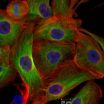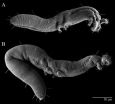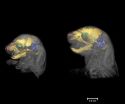(Press-News.org) Children who suffer from frequent nightmares or bouts of night terrors may be at an increased risk of psychotic experiences in adolescence, according to new research from the University of Warwick.
The study, published today in the journal SLEEP, shows that children reporting frequent nightmares before the age of 12 were three and a half times more likely to suffer from psychotic experiences in early adolescence. Similarly, experiencing night terrors doubled the risk of such problems, including hallucinations, interrupted thoughts or delusions. Younger children, between two and nine years old, who had persistent nightmares reported by parents had up to one and a half times increased risk of developing psychotic experiences.
Nightmares are considered to be commonplace in young children with incidence reducing as they grow older. They occur in the second half of sleep during REM (rapid eye movement) sleep. Those who have experienced them will be familiar with the sensation of waking suddenly with a sense of fear, worry and possible palpitations.
Night terrors, a sleep disorder, differ from nightmares and occur during deep sleep (non-REM) cycles in the first half of the night. A night terror bout is often signified by a loud scream and the individual sitting upright in a panicked state, though unaware of any of the involuntary action. The thrashing of limbs and rapid body movements are witnessed in more extreme cases. Children wake up in the morning unaware of their activity throughout the night.
Professor Dieter Wolke explained, "We certainly don't want to worry parents with this news; three in every four children experience nightmares at this young age. However, nightmares over a prolonged period or bouts of night terrors that persist into adolescence can be an early indicator of something more significant in later life."
The cohort was assessed six times between the ages of two and nine. The likelihood of experiencing psychotic experiences in adolescence increased with the incidence of nightmares. Those who only reported one period of recurrent nightmares saw a 16% rise, whereas those who reported three or more sustained periods of nightmares throughout the study saw a 56% increase in risk.
In contrast, problems with falling asleep or night waking (insomnia) had no relationship to later psychotic experiences.
Dr Helen Fisher, of King's College London, added, "The best advice is to try to maintain a lifestyle that promotes healthy sleep hygiene for your child, by creating an environment that allows for the best possible quality of sleep. Diet is a key part of this, such as avoiding sugary drinks before bed, but at that young age we'd always recommend removing any affecting stimuli from the bedroom – be it television, video games or otherwise. That's the most practical change you can make."
Lucie Russell, Director of Campaigns at YoungMinds, said, "This is a very important study because anything that we can do to promote early identification of signs of mental illness is vital to help the thousands of children that suffer. Early intervention is crucial to help avoid children suffering entrenched mental illness when they reach adulthood."
By the age of twelve, around one in four (24.4%) of children in the study reported having suffered from nightmares in the previous six months, with fewer than one in ten (9.3%) experiencing episodes of night terrors during the same period.
INFORMATION:
Notes:
The cohort used was the Avon Longitudinal Study of Parents and Children (ALSPAC), popularly known as Children of the 90s, a birth cohort study based in South West England.
These data are based on the children's own reports and should therefore be interpreted with caution, according to the authors.
Frequent childhood nightmares may indicate an increased risk of psychotic traits
2014-02-28
ELSE PRESS RELEASES FROM THIS DATE:
Study links poor sleep quality to reduced brain gray matter in Gulf War vets
2014-02-28
DARIEN, IL – A new study of Gulf War veterans found an association between poor sleep quality and reduced gray matter volume in the brain's frontal lobe, which helps control important processes such as working memory and executive function.
"Previous imaging studies have suggested that sleep disturbances may be associated with structural brain changes in certain regions of the frontal lobe," said lead author Linda Chao, associate adjunct professor in the Departments of Radiology and Biomedical Imaging and Psychiatry at the University of California, San Francisco. "The ...
Researchers identify brain differences linked to insomnia
2014-02-28
Johns Hopkins researchers report that people with chronic insomnia show more plasticity and activity than good sleepers in the part of the brain that controls movement.
"Insomnia is not a nighttime disorder," says study leader Rachel E. Salas, M.D., an assistant professor of neurology at the Johns Hopkins University School of Medicine. "It's a 24-hour brain condition, like a light switch that is always on. Our research adds information about differences in the brain associated with it."
Salas and her team, reporting in the March issue of the journal Sleep, found that ...
UCLA study finds robotic-assisted prostate surgery offers better cancer control
2014-02-28
An observational study from UCLA's Jonsson Comprehensive Cancer Center has found that prostate cancer patients who undergo robotic-assisted prostate surgery have fewer instances of cancer cells at the edge of their surgical specimen and less need for additional cancer treatments like hormone or radiation therapy than patients who have traditional "open" surgery.
The study, published online Feb. 19 in the journal European Urology, was led by Dr. Jim Hu, UCLA's Henry E. Singleton Professor of Urology and director of robotic and minimally invasive surgery in the urology ...
Let there be tissue-penetrating light: Scientists develop new nanoscale method to fight cancer
2014-02-28
Researchers from UCLA's Jonsson Comprehensive Cancer Center have developed an innovative cancer-fighting technique in which custom-designed nanoparticles carry chemotherapy drugs directly to tumor cells and release their cargo when triggered by a two-photon laser in the infrared red wavelength.
The research findings by UCLA's Jeffrey Zink, a professor of chemistry and biochemistry, and Fuyu Tamanoi, a professor of microbiology, immunology and molecular genetics, and their colleagues were published online Feb. 20 in the journal Small and will appear in a later print ...
Robert Avery, D.O., M.S.C.E., studies innovations to improve vision in children with tumors
2014-02-28
Robert Avery, DO, MSCE, of Children's National Health System and colleagues are establishing innovative approaches with technology and medication to improve the vision of young children who have visual pathway glioma, a type of brain tumor.
Most optic pathway gliomas cause vision loss in children between one and eight years of age. As many as 20 percent of children with neurofibromatosis type 1 -- a genetic disorder that occurs in 1 in every 4,000 births – may develop these tumors. It is estimated that nearly half of those children may experience vision problems from ...
Tackling tumors with space station research
2014-02-28
In space, things don't always behave the way we expect them to. In the case of cancer, researchers have found that this is a good thing: some tumors seem to be much less aggressive in the microgravity environment of space compared to their behavior on Earth. This observation, reported in research published in February by the FASEB Journal, could help scientists understand the mechanism involved and develop drugs targeting tumors that don't respond to current treatments. This work is the latest in a large body of evidence on how space exploration benefits those of us on ...
Worm-like mite species discovered on Ohio State's campus
2014-02-28
COLUMBUS, Ohio – It looks like a worm and moves like a worm – sort of. But it is a previously unidentified microscopic species of mite that was discovered by a graduate student on The Ohio State University campus.
Affectionately dubbed the "Buckeye Dragon Mite" by Ohio State's Acarology Laboratory, the mite is officially named Osperalycus tenerphagus, Latin for "mouth purse" and "tender feeding," in a nod to its complex and highly unusual oral structure.
This mite doesn't resemble a mythological winged dragon, but the snake-like Chinese dancing dragons that appear in ...
3-D imaging sheds light on Apert syndrome development
2014-02-28
Three dimensional imaging of two different mouse models of Apert Syndrome shows that cranial deformation begins before birth and continues, worsening with time, according to a team of researchers who studied mice to better understand and treat the disorder in humans.
Apert Syndrome is caused by mutations in FGFR2 -- fibroblast growth factor receptor 2 -- a gene, which usually produces a protein that functions in cell division, regulation of cell growth and maturation, formation of blood vessels, wound healing, and embryonic development. With certain mutations, this gene ...
GOES-West satellite eyes soggy storm approaching California
2014-02-28
A swirling Eastern Pacific Ocean storm system headed for California was spotted by NOAA's GOES-West satellite on February 28. According to the National Weather Service, this storm system has the potential to bring heavy rainfall to the drought-stricken state.
The storm was captured using visible data from NOAA's GOES-West or GOES-15 satellite on Feb. 28 at 1430 UTC/6:30 a.m. PST was made into an image by NASA/NOAA's GOES Project at NASA's Goddard Space Flight Center in Greenbelt, Md. The storm's center appeared as a tight swirl, with bands of clouds and showers already ...
NASA satellite sees great freeze over Great Lakes
2014-02-28
At night, as cold settles in, lake ice creaks and groans. It's been excessively cold, and I camped exposed on the snow-swept surface. Other than the lack of vegetation and the sounds at night, you'd never know you were on a lake. It feels like an empty plain. In some places, you see pressure ridges where ice has pushed into itself, sticking up like clear blue stegosaurus plates. -- Craig Childs
Author Craig Childs is not describing an Arctic lake. He's describing the bitterly cold and frozen scene on Lake Superior, during his February 2014 trek on the ice near the coast ...




